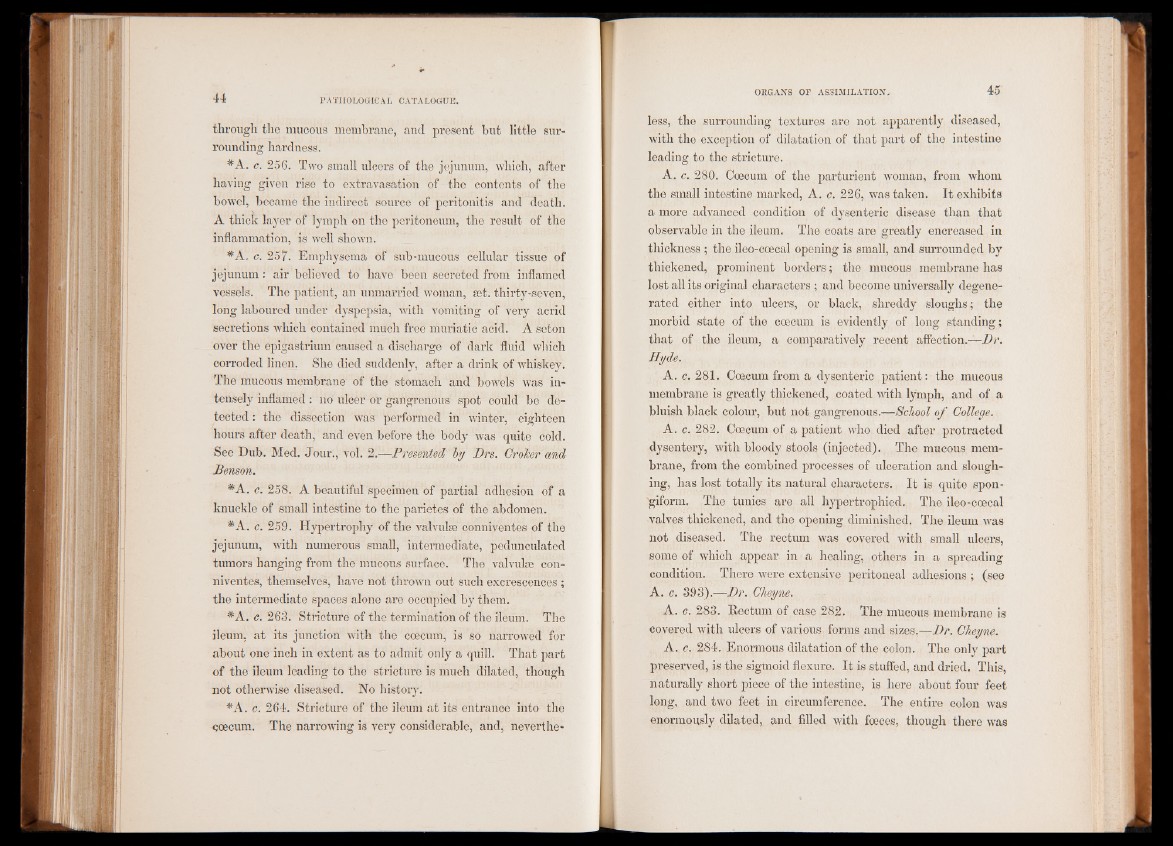
44 PATHOLOGICAL CATALOGUE.
through the mucous membrane, and present but little surrounding
hardness.
*A. c. 256. Two small ulcers of the jejunum, which, after
having given rise to extravasation of the contents of the
bowel, became the indirect source of peritonitis and death.
A thick layer of lymph on the peritoneum, the result of the
inflammation, is well shown.
#A. c. 257. Emphysema of sub-mucous cellular tissue of
jejunum : air believed to have been secreted from inflamed
vessels. The patient, an unmarried woman, æt. thirty-seven,
long laboured under dyspepsia, with vomiting of very acrid
secretions which contained much free muriatic acid. A seton
over the epigastrium caused a discharge of dark fluid which
corroded linen. She died suddenly, after a drink of whiskey.
The mucous membrane of the stomach and bowels was intensely
inflamed : no ulcer or gangrenous spot could be detected
: the dissection was performed in winter, eighteen
hours after death, and even before the body was quite cold.
See Dub. Med. Jour., vol. 2.—Presented ly Drs. CroJcer and
Benson.
#A. c. 258. A beautiful specimen of partial adhesion of a
knuckle of small intestine to the parietes of the abdomen.
#A. c. 259. Hypertrophy of the valvulæ conniventes of the
jejunum, with numerous small, intermediate, pedunculated
tumors hanging from the mucous surface. The valvulæ conniventes,
themselves, have not thrown out such excrescences ;
the intermediate spaces alone are occupied by them.
#A. c. 263. Stricture of the termination of the ileum. Thé
ileum, at its junction with the cæcum, is so narrowed for
about one inch in extent as to admit only a quill. That part
of the ileum leading to the stricture is much dilated, though
not otherwise diseased. No history.
*A. c. 264. Stricture of the ileum at its entrance into the
cæcum. The narrowing is very considerable, and, neverthe*
less, the surrounding textures are not apparently diseased,
with the exception of dilatation of that part of the intestine
leading to the stricture.
A. c. 280. Cæcum of the parturient woman, from whom
the small intestine marked, A. c. 226, was taken. It exhibits
a more advanced condition of dysenteric disease than that
observable in the ileum. The coats are greatly encreased in
thickness ; the ileo-coecal opening is small, and surrounded by
thickened, prominent borders ; the mucous membrane has
lost all its original characters ; and become universally degenerated
either into ulcers, or black, shreddy sloughs ; the
morbid state of the cæcum is evidently of long standing;
that of the ileum, a comparatively recent affection.—Dr.
Hyde.
A. c. 281. Coacum from a dysenteric patient: the mucous
membrane is greatly thickened, coated with ly'mph, and of a
bluish black colour, but not gangrenous.—School of College.
A. c. 282. Cæcum of a patient who died after protracted
dysentery, with bloody stools (injected). The mucous membrane,
from the combined processes of ulceration and sloughing,
has lost totally its natural characters. It is quite spon-
'giforin. The tunics are all hypertrophied. The ileo-coecal
valves thickened, and the opening diminished. The ileum was
not diseased. The rectum was covered with small ulcers,
some of which appear in a healing, others in a spreading
condition. There were extensive peritoneal adhesions; (see
A. c. 393).—Dr. Cheyne.
A. c. 283. Rectum of case 282. The mucous membrane is
covered with ulcers of various forms and sizes.—Dr. Clieyne.
A. c. 284. Enormous dilatation of the colon. The only part
preserved, is the sigmoid flexure. It is stuffed, and dried. This,
naturally short piece of the intestine, is here about four feet
long, and two feet in circumference. The entire colon was
enormously dilated, and filled with fceces, though there was